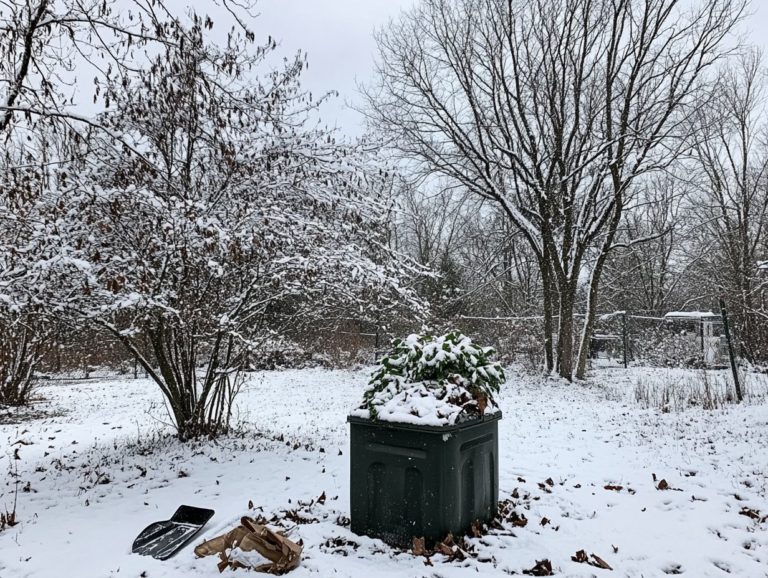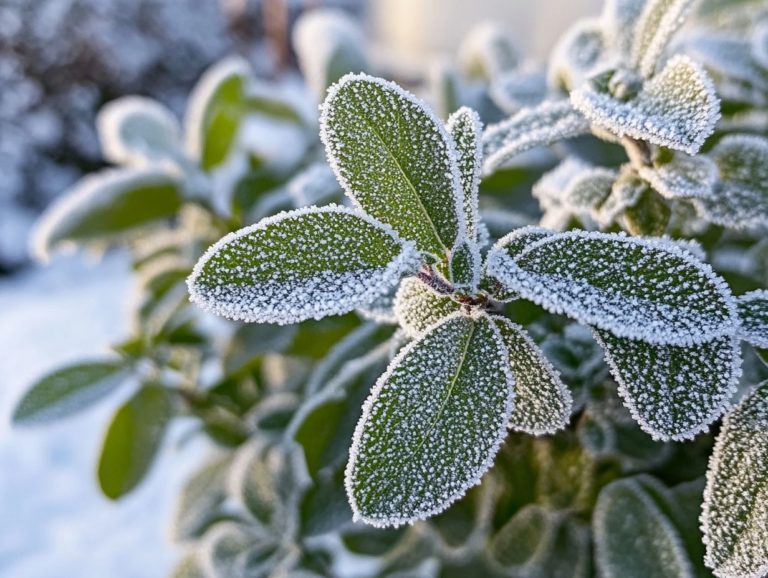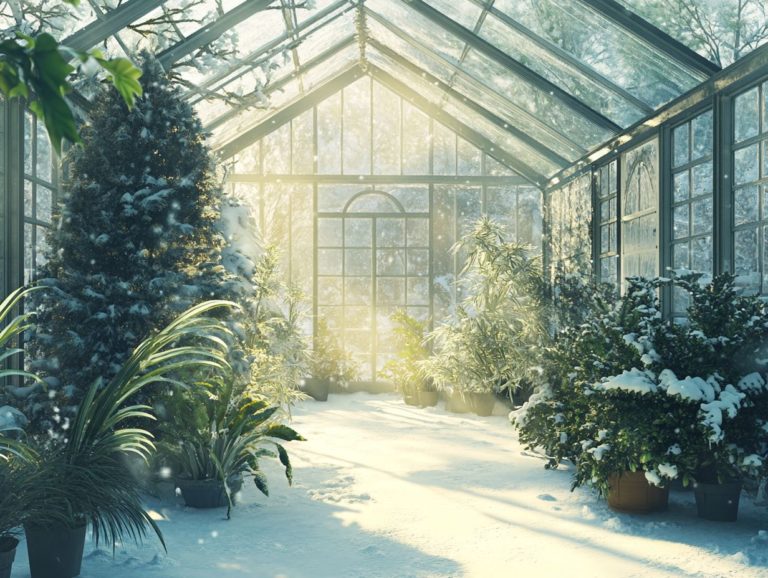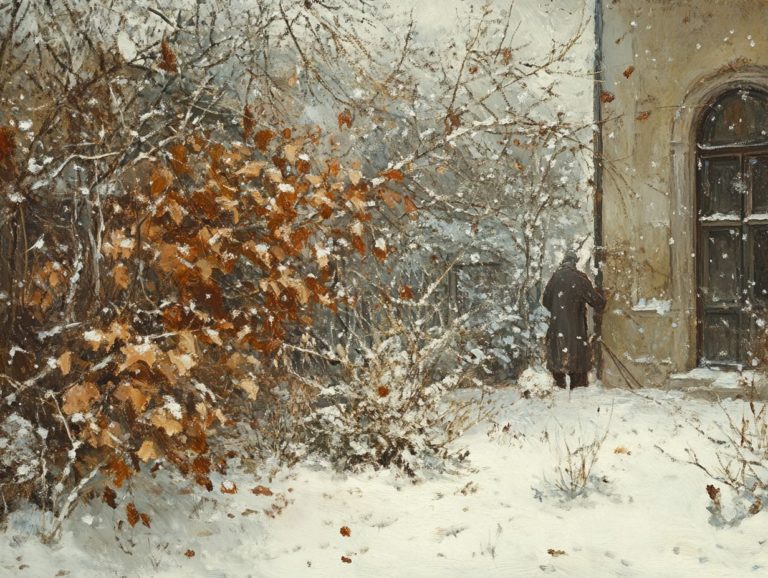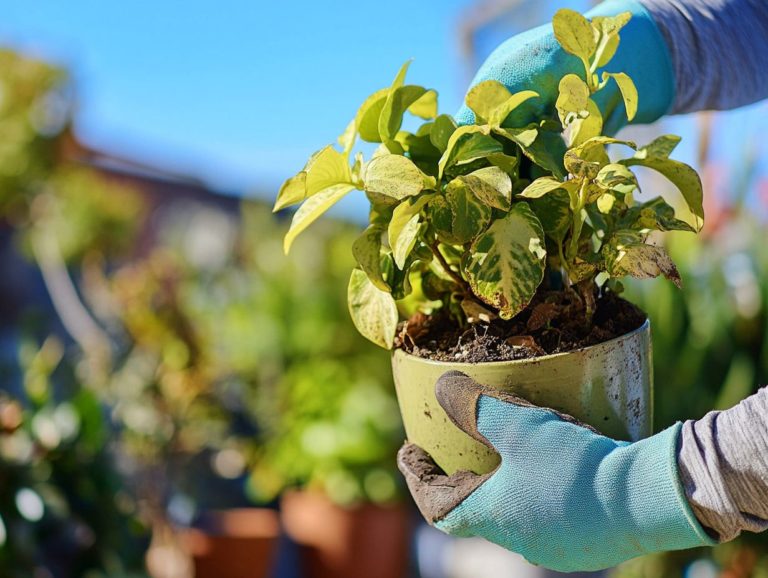Winter Plant Care: Essential Guidelines
As winter approaches, it becomes essential for you to ensure your plants thrive through the colder months, especially focusing on indoor gardening and houseplants.
This guide delves into effective strategies for preparing both your indoor and outdoor plants for winter survival. From cleaning and pruning to winterizing techniques, it covers all the necessary steps for winter plant care.
You ll discover how to manage light, temperature, and watering for your indoor plants. You ll also learn about protective measures for outdoor plants, ensuring their overall health.
Common winter issues include pests like aphids and spider mites, as well as diseases. Together, let s keep your garden flourishing this winter!
Contents
- Key Takeaways:
- Preparing Your Plants for Winter
- Indoor Winter Plant Care
- Outdoor Winter Plant Care
- Common Winter Plant Problems
- Frequently Asked Questions
- What are some essential guidelines for caring for plants during the winter?
- How often should I water my plants during the winter?
- What can I do to ensure my plants receive enough light during the winter?
- Are there any specific types of plants that thrive during the winter?
- How can I protect my outdoor plants from frost and extreme cold?
- Do I need to fertilize my plants during the winter?
Key Takeaways:
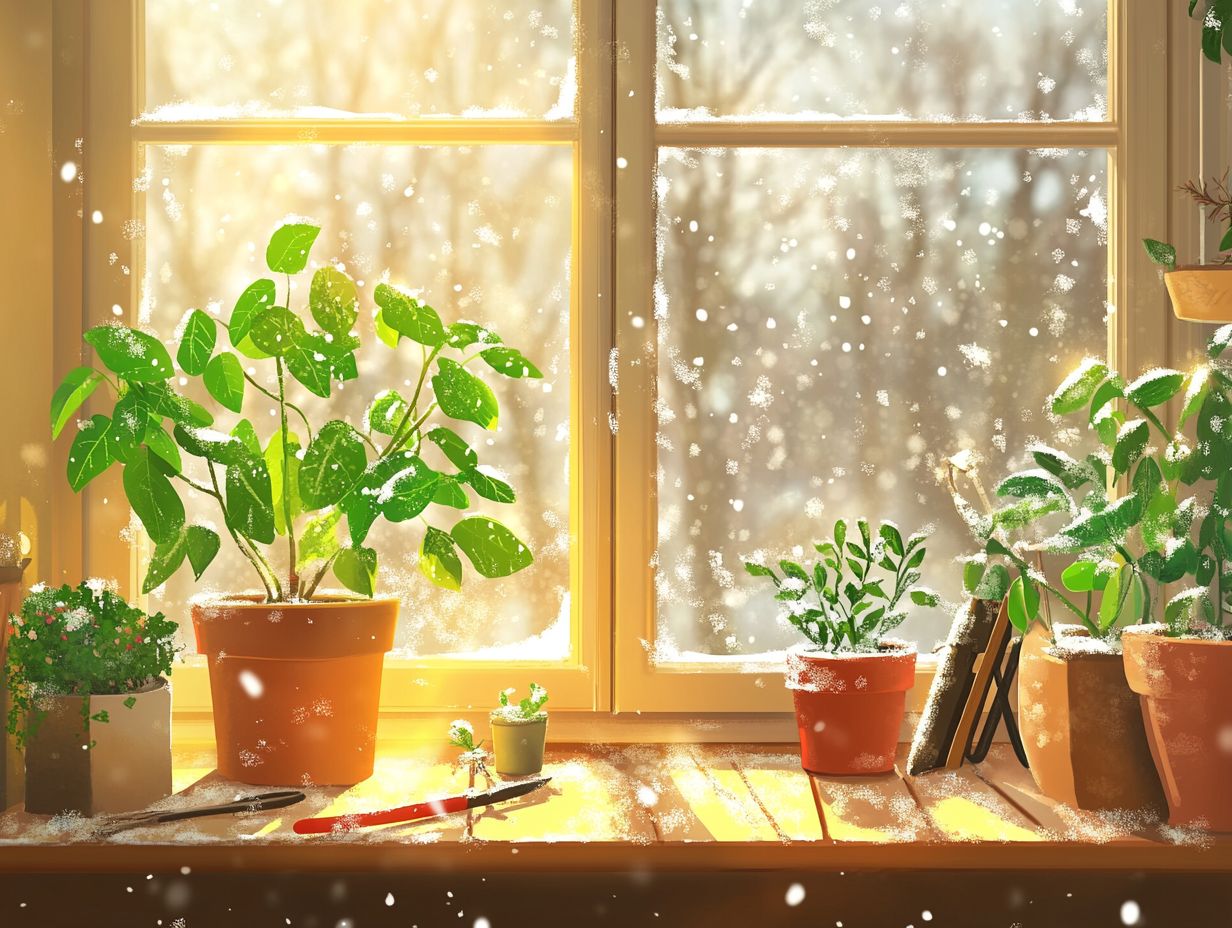
- Clean and prune your plants before winter. This promotes healthy growth.
- Adjust light and temperature for your indoor plants. This ensures they get what they need to thrive.
- Protect outdoor plants from cold. Monitor their health and treat any pest or disease promptly.
Preparing Your Plants for Winter
Properly preparing your plants for winter is crucial for ensuring their survival and vibrant growth during the cold months ahead. As winter approaches, it s common for gardeners to overlook the unique needs of houseplants.
It s essential to adjust your care routines to adapt to shifts in light, temperature, and humidity. Also, consider the moisture levels in the soil.
Take proactive steps like cleaning leaves and keeping track of how often you water. Employing effective winterizing techniques creates a nurturing environment for your plants while addressing potential winter challenges, including maintaining the right air humidity.
Cleaning and Pruning
Cleaning and pruning your indoor plants before winter not only elevates their appearance but also helps keep your plants healthy. Dust can block sunlight and affect their growth.
This essential maintenance routine eliminates pests such as scale and spider mites, and diseases. By removing any buildup, you enable your plants to absorb more light a crucial advantage as the days grow shorter in winter, especially for those needing bright, indirect sunlight.
Addressing any signs of infestation promptly can prevent further damage and safeguard the overall health of your indoor garden. Remember, different types of plants require specific pruning techniques; for instance, a spider plant flourishes with gentle leaf trimming, while a pothos often benefits from more substantial cuts to encourage bushier growth and healthy roots.
By adopting these practices, you not only enhance the vitality of your plants but also create a more visually appealing indoor environment, fostering a thriving indoor garden.
Winterizing Techniques
Implementing effective winterizing techniques for your indoor garden is essential for helping your plants adapt to the colder environment. This ensures they thrive and remain vibrant throughout the winter months while maintaining their moisture levels.
To achieve this, consider adjusting your watering routines, as many houseplants require less moisture when temperatures drop. They may experience drought.
Make sure to regularly check humidity levels they re vital for your plants’ health. Indoor heating can create dry air that negatively impacts plant health. Proper drainage is equally important; ensure your pots have adequate drainage holes to prevent root rot and maintain healthy soil.
Additionally, providing sufficient light sources is vital during those shorter winter days. Your plants may become leggy without enough illumination, impacting their overall growth.
By integrating these practices, you can cultivate a thriving indoor oasis that gracefully withstands winter s challenges, ensuring your plants remain healthy and vibrant.
Indoor Winter Plant Care
Grasping the specific light and temperature needs for indoor winter plant care is essential for preserving their health. It also encourages optimal growth during the colder months.
These conditions play a crucial role in influencing hydration and nutrient absorption, ensuring your plants thrive even when the weather outside is less than hospitable, especially in terms of moisture levels and sunlight.
Light and Temperature Requirements
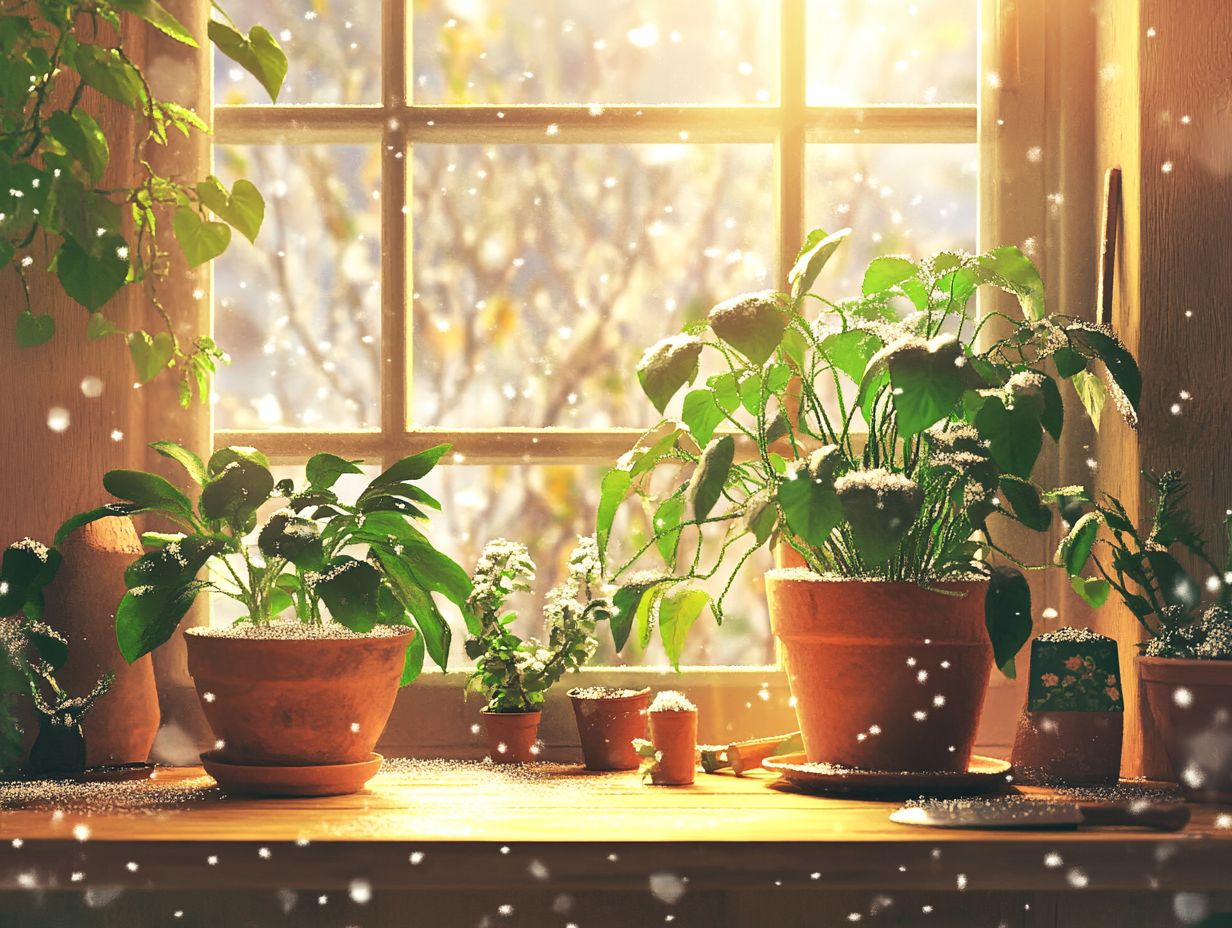
Indoor plants thrive under specific light and temperature conditions. Grasping these factors is crucial for successful winter gardening and ensuring a balanced environment for their growth.
Illumination plays a vital role. Most indoor plants thrive with bright, indirect sunlight for about six to eight hours each day. If you find yourself in a space with lower light, consider options like snake plants or pothos. They adapt remarkably well to dimmer conditions, making them great choices for indoor gardening.
When natural light is in short supply, consider using LED grow lights for extra light. Keeping temperatures between 65 F and 75 F promotes optimal growth. Monitor humidity levels closely to enhance the environment, ensuring your greenery stays vibrant and healthy throughout the chillier months.
Watering and Fertilizing
Establishing an effective watering and fertilizing routine is vital for maintaining moisture levels and providing the necessary nutrients for your indoor plants during winter.
In this colder season, it s easy to overlook the need for regular moisture checks. The diminished light and lower temperatures can lead to misunderstandings about your plants’ water needs. Adjust the watering frequency based on each plant s specific needs. Remember, overwatering can lead to root rot, while underwatering might stress your plants.
Selecting the right fertilizers, especially those formulated for winter, can significantly enhance your plants vitality. Monitor moisture levels closely whether through soil tests or simply by touch to ensure your indoor greenery thrives throughout the winter months.
Outdoor Winter Plant Care
Caring for your outdoor plants during winter requires awareness of the challenges presented by cold weather, snow, and ice. By implementing effective protection strategies, you can safeguard their health and vitality, ensuring they thrive even through harsh conditions.
Cold Weather Protection
Cold weather protection for your outdoor plants is essential for their survival and maintaining a thriving environment throughout the winter months.
By taking proactive measures, you can enhance the health of your plants as temperatures drop. For instance, applying a thick layer of mulch insulates the roots and helps retain moisture in the soil, which is vital during colder spells.
Consider creating windbreaks with fences or strategically placed evergreen shrubs to shield delicate foliage from harsh winter winds. For added protection, use plant covers or frost cloths to guard your plants against biting cold and heavy snow accumulation.
Implementing these strategies will support your outdoor plants through the chilly season, ensuring they remain vibrant and ready to thrive when spring arrives.
Dealing with Snow and Ice
When managing outdoor plants in winter, effectively addressing snow and ice build-up is crucial to prevent damage and ensure they thrive in the upcoming seasons.
With the right techniques, you can minimize the risks that harsh winter conditions pose to your cherished greenery. It s important to gently brush off accumulated snow with a soft broom; this helps alleviate pressure and prevent breakage.
Ice can be a bit trickier use warm water carefully to melt it, but proceed cautiously to avoid shocking the plant, especially the delicate roots.
Consider wrapping delicate stems with protective materials or investing in frost cloths to shield them from the biting cold. Ensuring proper hydration before frost sets in is vital for fortifying your plants against winter stress, promoting resilience throughout the chillier months.
Common Winter Plant Problems
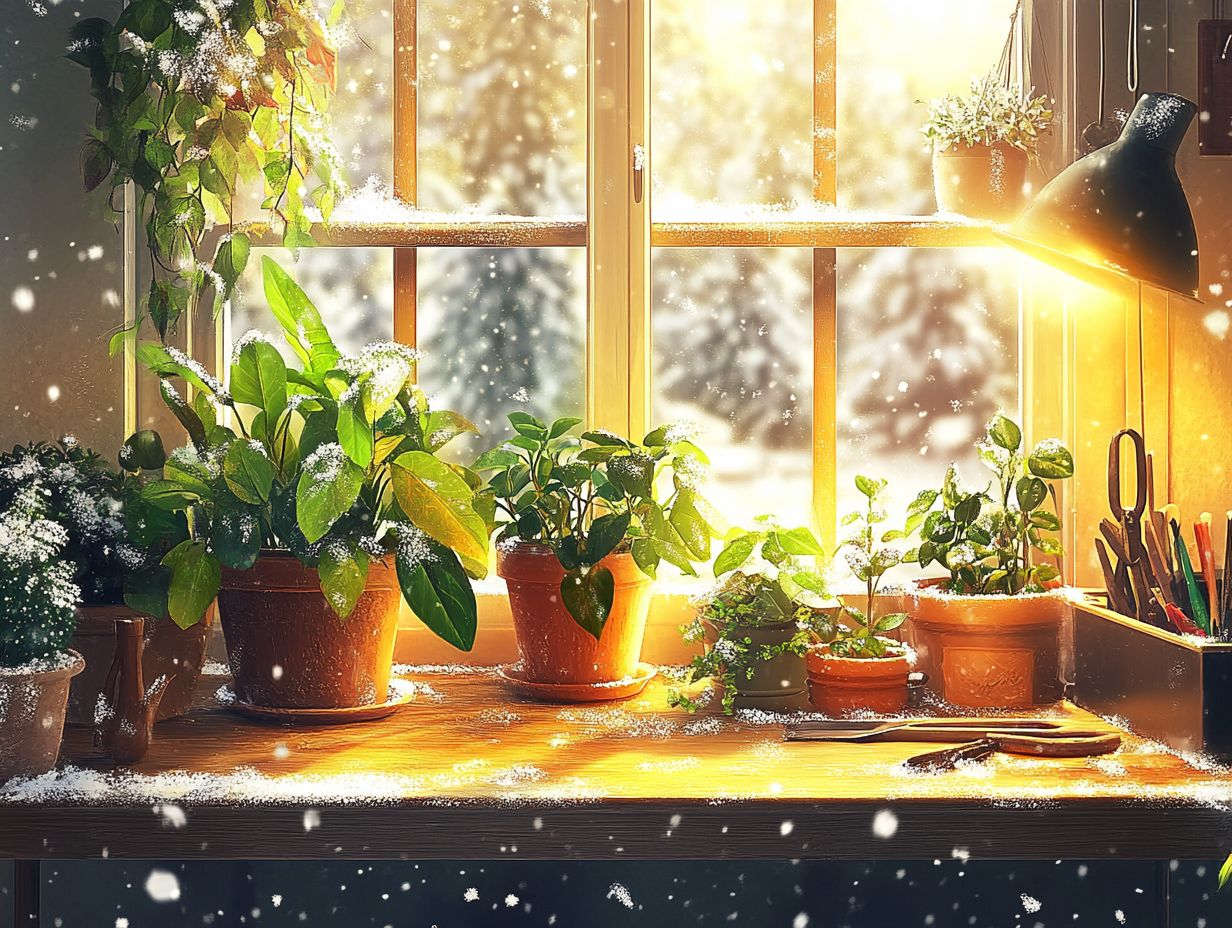
Being aware of common winter plant challenges, like pest problems from aphids and diseases, is essential for preserving the health of your plants during the colder months. This knowledge enables you to take timely action, ensuring their vitality and resilience throughout the season.
Effective plant care is critical during winter.
Pest and Disease Prevention
Pest and disease prevention is crucial for your indoor plants during winter. The conditions can inadvertently encourage harmful pests like aphids and spider mites to emerge, affecting their growth and health.
Keep a vigilant eye on the foliage to allow for early detection of any unsettling changes that could signal trouble. This ensures their overall health.
Another important strategy is to maintain optimal humidity levels. Excessively dry air can create a welcoming environment for pests. Embracing organic treatments, such as neem oil (a natural pesticide) or insecticidal soap (a soap that kills pests), can also offer an eco-friendly line of defense, ensuring your plants remain healthy.
By using these simple strategies consistent monitoring, humidity management, and choosing natural solutions you can create a thriving indoor garden while minimizing the risk of infestations or diseases.
Identifying and Treating Issues
Identifying and addressing issues that arise during winter, especially those related to pests and diseases, is crucial for maintaining the health of your plants.
During this time, be vigilant for subtle signs of distress, such as yellowing leaves, stunted growth, or wilting. These may indicate underlying problems.
Recognizing these indicators early can help you prevent more severe damage and encourage recovery. Inadequate light or fluctuations in humidity can exacerbate issues, making it vital to understand the environmental needs of each of your plants.
To treat common ailments naturally, consider using:
- Organic fertilizers
- Adjusting watering schedules
- Introducing beneficial insects
Start now to ensure your plants thrive this winter! By doing so, you foster a balanced ecosystem that supports healthy growth.
Frequently Asked Questions
What are some essential guidelines for caring for plants during the winter?
Some essential guidelines for winter planting care include adjusting watering schedules, providing adequate lighting, and protecting plants from extreme temperature changes.
How often should I water my plants during the winter?
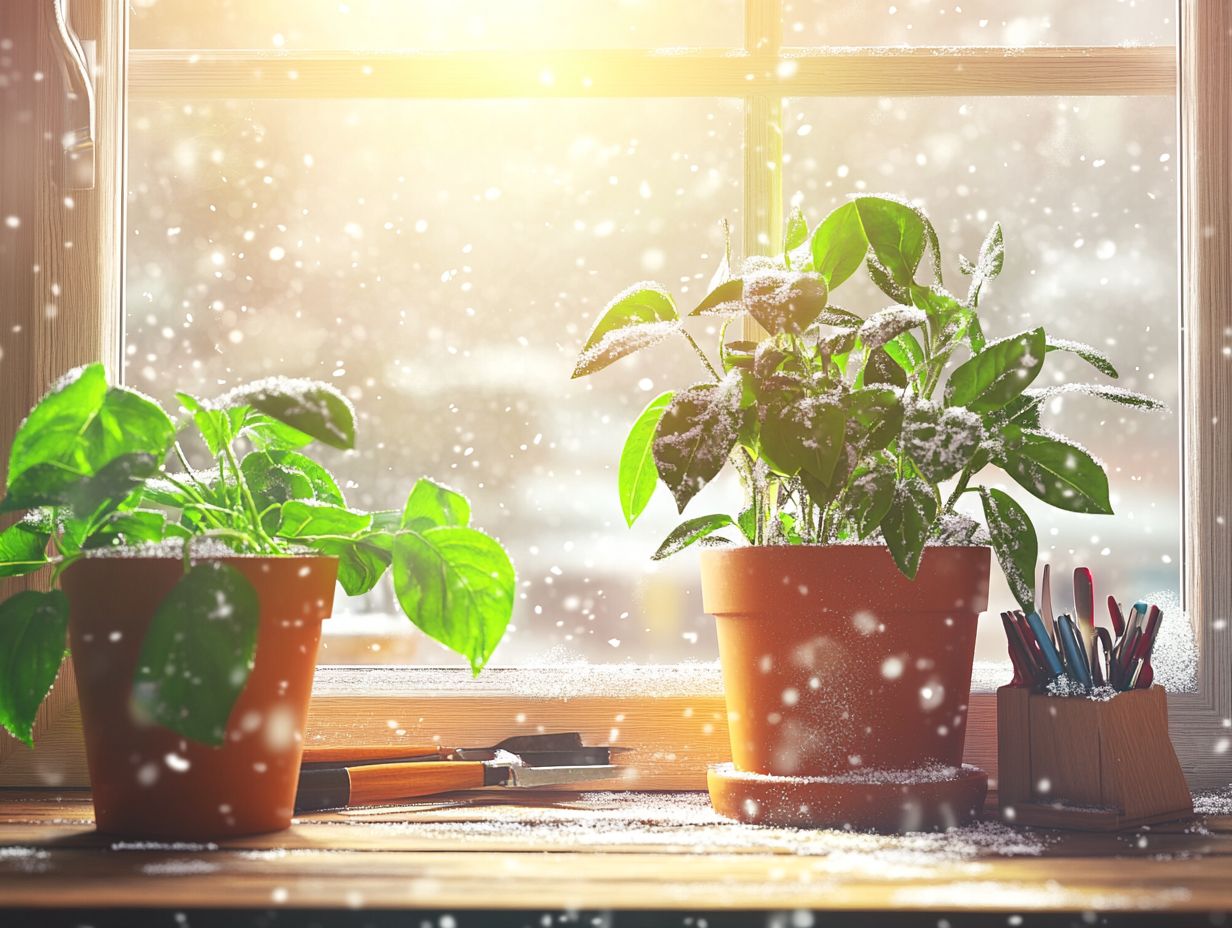
The frequency of watering will depend on the type of plant and its specific needs. However, in general, plants require less frequent watering during the winter months due to lower levels of sunlight and cooler temperatures.
What can I do to ensure my plants receive enough light during the winter?
If your plants are not receiving enough natural sunlight, supplement with artificial lighting. LED grow lights are a popular option for indoor plants during the winter.
Are there any specific types of plants that thrive during the winter?
Yes, there are many types of plants that are well-suited for the winter season. Some examples include poinsettias, Christmas cactus, and winter jasmine.
How can I protect my outdoor plants from frost and extreme cold?
To protect outdoor plants, cover them with a sheet or blanket overnight to trap heat. You can also move potted plants indoors or into a sheltered area.
Do I need to fertilize my plants during the winter?
In most cases, plants do not need to be fertilized during the winter as their growth slows down. However, if your plant shows signs of nutrient deficiency, you may need to fertilize with a diluted solution.
For further resources on winter plant care, be sure to explore more information!

